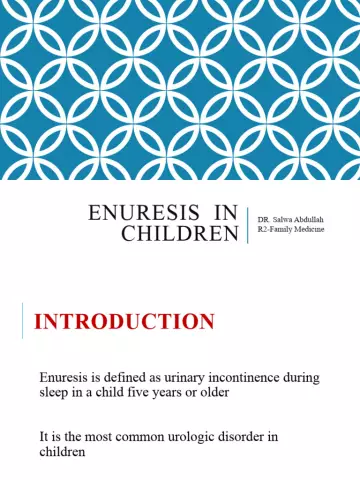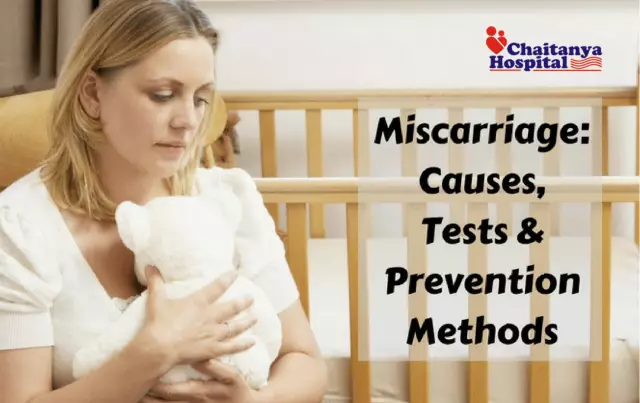- Author Rachel Wainwright [email protected].
- Public 2023-12-15 07:39.
- Last modified 2025-11-02 20:14.
Enuresis
General information about the disease

Enuresis is the spontaneous emission of urine during sleep at night (nocturnal enuresis) and during the day. The most common occurrence is enuresis in children. It should be noted that the diagnosis of enuresis is legitimate when the symptoms of the disease appear in children at the age of 4, because the child should already develop the skill of retention of urine when urging. With normal development, at 6 months, 80% of children disappear incontinence during daytime sleep. At the age of one and a half years in 70% of children, cases of such incontinence are more episodic (once every seven days), and involuntary urination at night no longer occurs.
Bedwetting occurs in adults. The reasons for this deviation lie more in the physical nature of the disease than the psychological one: enuresis in adults is most often caused by injuries of the spine or bladder, various diseases of the genitourinary system, and accompanying surgical interventions.
There are several types of enuresis in children: a simple form, neurotic, neuropathic, endocrinopathic, epileptic, dysplastic. And such forms of enuresis in adults are known: urgent, stressful and mixed. Each of these forms has its own clinical picture.
The clinical picture of day and night enuresis
With a simple form of enuresis in children, there are rare, but constant (from 2 to 5 times a week) cases of involuntary urination in the first half of the night, during the deep sleep phase. This form of enuresis in children is most often hereditary and goes unnoticed for them, without causing psychological distress.
But the neurotic form of enuresis in children, on the contrary, causes them to have emotional reactions of a negative nature. The child is worried about his "defect", on this basis, even suicide attempts were recorded. This form of nocturnal enuresis is rare, and it is accompanied by all kinds of neurotic manifestations - irritability, lability of the psyche, sleep disturbances, tics, moodiness and tearfulness, fears. The neurotic form of enuresis in children manifests itself in waves, since it directly depends on the emotional state of the child.
Neuropathic enuresis in children appears against the background of childhood nervousness, which is congenital in nature and is formed with changes in the nervous system, frequent colds at an early age. With this form of enuresis, there is a disturbance of sleep and sleep-wakefulness. In addition, in addition to nocturnal enuresis, a child may experience incontinence during daytime sleep, and the number of such cases increases with a cold.
Endocrinopathic enuresis is characterized mainly by nocturnal involuntary urination with concomitant endocrinopathies - obesity, paroxysmal temperature rises, diabetes.
The epileptic form of enuresis develops in epilepsy. Incontinence occurs as an explosion-like discharge of large amounts of urine. In this case, there is twitching of the limbs, holding of breath, autonomic disturbances.
Dysplastic enuresis is formed with an organic disorder of the regulation of urinary function. This form of nocturnal enuresis is characterized by incontinence during daytime sleep and encopresis (fecal incontinence).
The clinical picture of bedwetting in adults looks like this: the urgent form is expressed in incontinence caused by an "imperative" (very strong) urge, while the patient does not even have time to get to the toilet. Very often, urination occurs suddenly, and the urge is either very short or not at all.
Stressful enuresis is called urination during physical stimulation of the abdominal cavity, due to which there is pressure on the bladder. It can be running, lifting weights, even coughing and laughing. With this form of enuresis in adults, there is no urge to urinate.
Mixed enuresis in adults suggests that the patient has several forms of incontinence at once, with mixed symptoms.
A separate rare form of bedwetting in adults is overflow incontinence, which is associated with impaired urinary outflow and occurs mainly in older men, with diseases of the prostate gland.
Treatment of bedwetting
The process of treating bedwetting is different in adults and children.
For the treatment of bedwetting in children, the following methods are used: medication, non-medication (physiotherapy, psychotherapy, diet therapy), regime method.

The medical method is used mainly in cases of urinary tract infection and as part of the treatment of neurotic enuresis in children. In the first case, antibacterial drugs are used for treatment, and in the second case, the child is given tranquilizers with the effect of sleeping pills (eunoktin, radedorm) to restore the depth of sleep. In cases of resistance to these drugs, give melepramine, amitriptyline, sydnocarb. Also, nootropic drugs are used in treatment regimens: phenibut, semax, instenon, gliatilin, piracetam, glycine. A good result in the treatment of enuresis in children is observed after taking drops of Adiuretin-SD - this is a form of an artificial analogue of vasopressin - a hormone that is responsible for the release and absorption of free water.
Non-drug treatment for daytime and nighttime enuresis. Physiotherapy is usually used in conjunction with medication. This can be laser therapy, acupuncture, music therapy and other methods of influencing the nervous system of a child suffering from enuresis.
Psychotherapy also acts as part of a comprehensive treatment, serves to correct neurotic disorders.
Diet therapy is the development of a day menu with limited fluid intake.
Regime treatment of bedwetting in children. This method is a set of measures carried out by the child's parents at home: the establishment of a special diet and sleep.
For the treatment of bedwetting in adults, medical, non-drug methods and operations are used.
Medical treatment of enuresis with the use of antidepressants and antispasmodic drugs is used mainly for the treatment of urgent incontinence.
Non-drug treatment of bedwetting in adults consists in performing gymnastics for the pelvic muscles, training the bladder.
Surgery is practiced mainly for the treatment of stressful bedwetting in adults and overflow incontinence.
Prevention of day and night enuresis
To prevent the occurrence of bedwetting in children, the following recommendations should be followed:
1. Timely refuse diapers (from two years old);
2. Monitor the child's fluid intake during the day (taking into account the time of the year and the temperature indoors, outdoors);
3. To teach the child the rules of caring for the genitals, to monitor their implementation;
4. Timely treat urinary tract infections.
Prevention of bedwetting in adults is also the timely elimination of various diseases of the genitourinary system, limiting excessive physical exertion, if possible, observing safety rules at work or rest - in order to avoid injuries of the spine and pelvic region.
YouTube video related to the article:
The information is generalized and provided for informational purposes only. At the first sign of illness, see your doctor. Self-medication is hazardous to health!






